Planting Guide: Black Huckleberry (Vaccinium membranaceum)
? Tip: Think cool, acidic forest edge. Keep roots cool with conifer-duff mulch, use low-pH organic soil, and give afternoon shade in hot, low-elevation sites; steady summer moisture = better fruit.
Choosing a Site
Light: Full sun to part shade; in hotter/lower sites, aim for morning sun and afternoon shade.
Soil: Strongly acidic (roughly pH 4.3–5.5), well-drained, organic-rich. Blend in fine bark, rotted wood, peat/coir; avoid lime/alkaline amendments.
Space: Plant 3–5 ft apart; plants spread slowly by rhizomes to form clumps/patches.
Planting Steps
Plant in spring or fall (spring in cold-winter regions). Choose a wide, shallow hole and pre-moisten the planting mix.
Mix native soil with composted bark/leaf mold and a small amount of peat or coir for acidity and moisture retention.
Set the plant at the same depth as the container; loosen circling roots gently and avoid burying stems.
Water deeply to settle; mulch 2–3 in. with pine needles/conifer duff (keep mulch a few inches off stems).
In hot areas, provide temporary shade cloth or companion shade (ferns/heathers) for the first summers.
Watering & Care
Establishment: Keep evenly moist—not waterlogged—during the first 1–3 years.
After establishment: Moderately drought tolerant, but best crops come with consistent summer moisture.
Pruning: Minimal. Tip-back lightly after fruiting; remove dead/damaged wood in late winter. Avoid hard cuts.
Feeding: Light, acid-forming fertilizer only if growth is weak; annual top-dress with coniferous organic matter.
Pollination: Self-fertile; native bees improve set. Plant multiples to boost yield.
Heat & Airflow: Keep roots cool with mulch; shelter from hot, dry winds; provide airflow to limit leaf diseases.
Protection
Wildlife: Birds love the fruit—use lightweight netting if you need more for the kitchen.
Cold & Deer: Hardy shrub; protect young plants from deer where browse pressure is high.
Soil-borne issues: Avoid poorly drained sites to prevent root problems; water deeply but infrequently once established.
Companions: Pairs well with Evergreen Huckleberry, Red Huckleberry, Salal, and native ferns/heathers for a cool, multi-season understory.
Harvest Basics
Timeline: First light crops typically 3–5 years after planting (seed-grown plants can be slower).
Season: Mid/late summer into early fall—often August–September, later at higher elevations.
Use: Superb fresh or in pancakes, cobblers, jams, syrups, fruit leather; freeze whole to extend the season.









